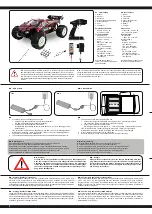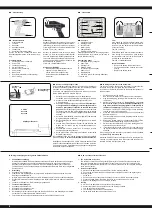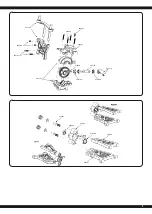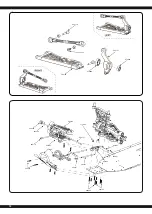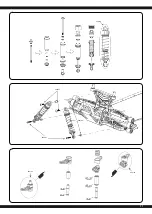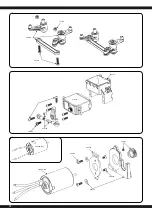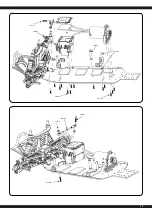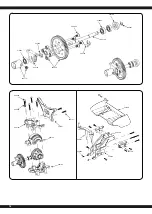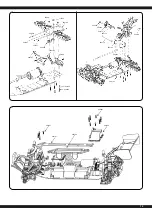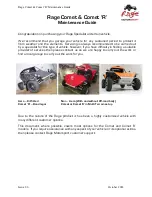
7
DE - Programmierung des Reglers
GB - Programming the ESC
Programmierphase
Program Mode
Programmwerte
Program Value
1
2
3
4
5
6
7
8
1. Fahrmodus
Drive Mode
vorwärts, Bremse an
Forwards, brake on
vor- / rückwärts,
Bremse an
forwards / reverse,
brake on
2. Zugbremse
Drag Brake Force
0 %
5 %
10 %
15 %
20 %
25 %
30 %
40 %
3. Unterspannung
Low Voltage
aus
OFF
2,6 V/Zelle
2,6 V/cell
2,8 V/Zelle
2,8 V/cell
3,0 V/Zelle
3,0 V/cell
3,2 V/Zelle
3,2 V/cell
3,4 V/Zelle
3,4 V/cell
4. Start Modus
Start Mode
sanft
soft
normal
normal
aggressiv
aggressive
sehr aggressiv
very aggressive
5. Bremskraft max.
Brake Max.
25%
50%
75%
100%
DE - Signale und Schutzeinrichtungen
Während des normalen Betriebsmodus haben die LED-Signale folgende Bedeutung:
a. Keine LED = Gasgeber in der Neutralposition
b. Rote LED = Fahrzeug bewegt sich vor- oder rückwärts
c. Grüne LED = Gasgeber befindet sich in der max. Vor- oder Rückwärtsposition
Durch Warnsignale macht der Regler auf bestimmte Zustände aufmerksam:
1.
Beim Einschalten überprüft der Prozessor die Eingangsspannung, wenn sie außerhalb der
zulässigen Grenzen liegt, ertönt ein Signal mit einer Sekunde Pause, zwischen den einzel-
nen Signalen “beep-beep-, beep-beep-, beep-beep-”
2.
Wenn das Eingangssignal nicht ordnungsgemäß ist, ertönt ein Signal mit zwei Sekunden
Pause, zwischen den einzelnen Signalen “beep-, beep-, beep-”. Dieser Regler ist mit einer
Reihe von Schutzeinrichtungen für einen sicheren Betrieb ausgestattet:
1. Unterspannungsabschaltung:
Sobald die Spannungslage eines LiPo-Akkus unter Last für eine Zeit von ca. 2 Sek. die
eingestellte Schwelle unterschreitet, wird die Motorleistung reduziert, bis sie anschließend
ganz abgeschaltet wird. Beachten Sie, dass der Motor nicht wieder gestartet werden kann,
wenn sich die Spannung unterhalb des voreingestellten Wertes befindet.
Achtung: Das Fahrzeug muss trotzdem manuell ausgeschaltet werden da sonst der
Akku weiter entladen wird und durch Unterspannung beschädigt werden kann.
2. Übertemperaturabschaltung
Sobald die Temperatur des Reglers, für eine Dauer von 5 Sek., den Wert von 95°C über-
schreitet, wird der Motor abgeschaltet. Nach dem Abschalten müssen Sie den Regler
unbedingt abkühlen lassen, da der Regler sonst beschädigt wird.
Diese Funkton darf nicht
deaktiviert werden!
3. Fehlerhaftes Eingangssignal
Sollte das Eingangssignal für eine Zeitdauer von 0,2 Sek. als nicht ordnungsgemäß erkannt
werden, wird der Motor abgeschaltet.
GB - LED’s, errors and protection
In normal use the LED will illuminate as follows:
a. No LED = the throttle control is in the neutral position
b. Red LED = the vehicle is driving forwards or in reverse.
c. Green LED = the vehicle is at full throttle either forwards or in reverse.
In certain circumstances the ESC will omit an acoustic tone to warn you of a problem:
1. On switching on, the ESC will check the battery pack voltage and if it falls outside the correct
values it will omit double signals followed by a 1 second pause: “beep-beep-, beep-beep-,
beep-beep-”
2. If the ESC does not receive a signal from the transmitter it will omit single signal followed by
a 2 second pause: “beep-, beep-, beep-”
The ESC has ben equipped with a series of protective circuits to ensure safe operation:
1.
Low voltage cut-off:
If the voltage drops below the set value for more than 2 seconds the ESC will switch the
motor off. Please note that the motor cannot be started again if the voltage is below the
choosen value per cell.
Attention: The vehicle must still be switched off manually because otherwise the
Battery is discharged further and can be damaged by undervoltage.
2.
Temperature cut-off
If the internal temperature of the ESC rises above 95°C for more than 5 seconds the motor
will switch off. After the ESC switches off it has to cool down before operating again.
Otherwise the ESC will be damaged.
This function should not be disabled!
3. Signal loss
If the signal is lost for more than 0.2 seconds the ESC will switch the motor off.
Die grau hinterlegten Felder geben die Werkseinstellung wieder.
The fields which are shaded in grey indicate the factory settings.
DE
Dieser Sender ist mit umfangreichen Konfigurationsmöglichkeiten ausgestattet. Damit Sie Ihr Ziel
einer optimalen Programmierung schnell und sicher erreichen, halten Sie sich an die begebildete
Menüstruktur und an die Tabelle der Programmiermöglichkeiten.
1. Fahrmodus:
Im Rennmodus Punkt 1 fährt das Fahrzeug nur vorwärts, die Bremse ist dabei aktiviert, rück-
wärts fahren ist ausgeschlossen. Dieser Modus ist gut geeignet für den Wettbewerbseinsatz.
Im Fahrmodus Punkt 2 (vorwärts/rückwärts mit Bremse) kann das Fahrzeug auch rückwärts
fahren mit aktivierter Bremsfunktion, dieser Modus eignet sich gut für normale Einsätze und
für das Training.
Hinweis:
Im 2. Fahrmodus müssen Sie mit einer Doppelbetätigung die Rückwärtsfahrt einleiten. Wenn
Sie den Geber aus der Vorwärts-Zone erstmals in die Rückwärts-Zone bewegen, bremst der
Motor. Dabei kommt das Fahrzeug aber nicht total zum stehen. Wenn jetzt der Geber noch-
mals in die Rückwärts-Zone gedrückt wird, fährt das Fahrzeug rückwärts, dabei hält es
zunächst kurzzeitig an. Wenn der Geber wieder nach vorn bewegt wird, egal ob sich der
Motor im Brems- oder Rückwärtsfahrmodus befindet, fährt das Auto wieder vorwärts.
2. Zugbremse:
In diesem Menü wird die Leerlaufbremswirkung der Bremse als %-Wert vorgegeben. Der
Einstellbereich liegt zwischen 0 und 40%.
3. Unterspannung:
In diesem Punkt kann die Abschaltschwelle vorgegeben werden. Der Einstellbereich liegt
zwischen 3,4 und 2,6 V pro Zelle. Sobald die Schaltschwelle unterschritten wird, schaltet der
Regler den Motor aus.
4. Start-Modus:
Mit dieser Option können Sie einstellen, wie der Start verlaufen soll, dabei können Sie unter
vier Vorgaben, vom sanften bis zum sehr aggressiven Start, wählen. Beachten Sie, dass für
die beiden schnellen Startmodi ’aggressiv’ und ’sehr aggressiv’ besonders leistungsfähige
Akkus mit geringem Innenwiderstand eingesetzt werden sollten. Es kommt sonst zu
Spannungseinbrüchen und der Motor läuft nur zögernd an. Außerdem müssen der Motor und
das Getriebe an den gewünschten Start-Modus angepasst sein.
5. Bremskraft max.:
Der Regler ist mit einer proportional zur Geberposition wirkenden Bremse ausgestattet. Die
stärkste Wirkung wird erzielt, wenn der Geber ganz nach vorn gedrückt wird. Eine starke
Bremswirkung bringt das Fahrzeug schnell zum stehen, ist aber andererseits mit einem
hohen Verschleiß der mechanischen Komponenten, wie z.B. dem Getriebe verbunden.
GB
This ESC is fitted with many useful functions and to help you to be able to make the most of the
various options they are explained below. Please use the programming table shown on page 6
together with these explanations to program your ESC quickly and effectively:
1. Drive mode:
If option 1 is selected in Drive mode, the vehicle will only drive forwards and the brake is
active which make this mode the best choice for racing. In mode 2 the vehicle can be driven
forwards or in reverse and the brake is also active. This mode is useful for general use and
training.
Note:
When option 2 is selected, moving the throttle control back past the neutral point will initially
activate the brake. If the throttle control is then moved back to the neutral position briefly the
ESC will switch over to reverse. Moving the ESC forwards will make the vehicle drive
forwards regardless of whether it was braking or moving in reverse.
2. Drag Brake force:
In this option the drag braking force can be set. The value is set as a percentage and the
values are from 0 to 40%
3. Low voltage:
In this option you can set the low voltage cut-off value. The cut-off voltage can be set between
3.4 and 2.6 Volts per cell. Once the cut-off voltage has been reached the motor will stop.
4. Start Mode:
With this option you can choose how the vehicle will accele rate when full throttle is applied
and you can set the value between ‘Soft‘ and ‘Very Aggressive‘. Please note that if you select
one of the 2 ‘Aggressive’ modes that you will need to have batteries with a very low internal
resistance otherwise the voltage will drop due to the high current draw and the motor may
stutter. Also ensure that your motor and gearing are capable of carrying the high loads.
5. Brake Max.:
The ESC is equipped with a braking system which works proportionally to the throttle control.
This means that the further the throttle control is moved rearwards the more braking force will
be applied. A higher value here will mean that the vehicle will brake harder but more strain will
be placed on the components, for example, the gearing.


